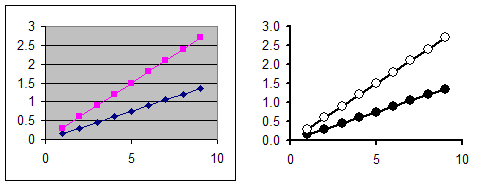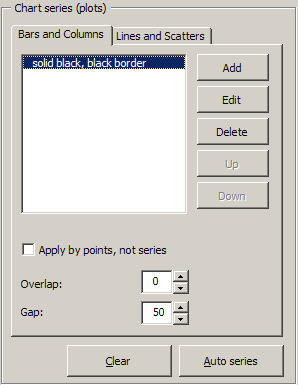By default, Excel produces charts that do not satisfy the needs of a scientific publisher: Thin lines, unfavorable colors with low contrast (blue on gray in Excel 2003®) or too much eye candy (gradients and shadows in Excel® 2007-2013). Use Daniel’s XL Toolbox to produce professional-looking graphs with a few mouse clicks.
The “Chart Design” function has been designed to make the process as quick and straight-forward as possible. Unnecessary settings have been eliminated, and common properties were combined. For example, to adjust the line widths of the chart axes, you no longer need to edit each axis individually.
Features
- Simple colors – black, white, gray; red, green, blue.
- Consistent line style for all lines.
- Consistent text style for all text elements.
- Apply format to selected chart or to all charts on the current worksheet.
- Save settings to files that can easily be archived and shared.
- Ability to format charts with mixed plots (e.g., bars and lines) – one of the advantages over Excel’s built-in chart template functionality.
Examples
Here are two examples produced with Excel® 2000: First a line chart: Left, the original; right, the same chart formatted with standard settings. Note how the number formatting of the Y axis was automatically adjusted to one decimal digit.

The following example shows a bar graph. In this example, basic color and patterns were applied.

Of course, you can also use this function with mixed charts.
Usage
Most of the options in the Design Chart dialog are all self-explanatory.
One element that is important to note is the list of series formats (see image).
There are separate style lists for bar/column plots on the one hand and line/scatter plots on the other. You need to define a style for for each chart series; click on Auto to obtain a set of style definitions.
Use the Add, Edit, Delete, Up, and Down buttons to modify your style definitions. Hint: Double-clicking a style definition in the list opens the Edit dialog.
You can save style definitions for future use by clicking on the Save button. Chart design files have the extension “.XLTBCD”; they are simply text files with a special extension.
 Apply chart design templates
Apply chart design templates

